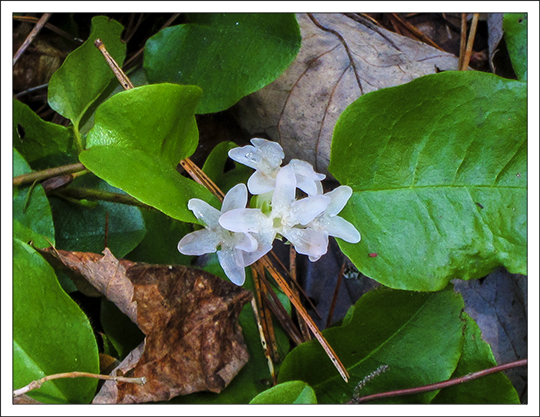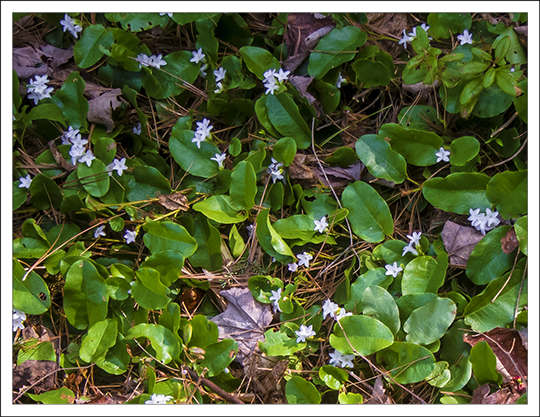Adirondack Wildflowers:
Trailing Arbutus (Epigaea repens)
| This page is no longer being updated. For an updated and expanded version of this material, see: Trailing Arbutus (Epigaea repens) |
 Adirondack Wildflowers: Trailing Arbutus along the Heron Marsh Trail at the Paul Smiths VIC (12 May 2013)
Adirondack Wildflowers: Trailing Arbutus along the Heron Marsh Trail at the Paul Smiths VIC (12 May 2013)
One of the earliest spring flowers in the Adirondack Mountains is the Trailing Arbutus (Epigaea repens). Its fragrant white or pink blooms generally appear before the deciduous trees leaf out. The delicate flowers are about 1/2 inch in diameter.
This plant is a native perennial subshrub and a member of the heath family. The name "Epigaea" comes from a Greek phrase meaning "upon the earth" -- a reference to the trailing growth of the plant. The name "repens" refers to the fact that the plant has creeping and rooting stems. Trailing Arbutus is also known as Mayflower and Plymouth Mayflower. The latter name is derived from the fact that the flowers of this plant were the first to greet the Pilgrim Fathers after their first winter. Trailing Arbutus became the state flower of Massachusetts in 1918; it is also the provincial flower of Nova Scotia.
The plant forms a creeping mat, usually between four and six inches high. The deep green, glossy evergreen leaves are oval and aromatic. The stem is hairy and trailing. Trailing Arbutus is a larval host for the Hoary Elfin butterfly.
The plant was reportedly used by native Americans for medicinal purposes. Algonquins reportedly used an infusion of its leaves for kidney disorder, while Cherokee tribes are said to have used it for abdominal pains, chest pains, and indigestion. The Iroquois reportedly used it for labor pains, rheumatism, and kidney ailments..
 Adirondack Wildflowers: Trailing Arbutus along the Heron Marsh Trail at the Paul Smiths VIC (8 May 2013)
Adirondack Wildflowers: Trailing Arbutus along the Heron Marsh Trail at the Paul Smiths VIC (8 May 2013)
Trailing Arbutus grows in woodland in the eastern half of the United States, including New York State. According to the USDA, the plant is considered "exploitably vulnerable" in New York. Trailing Arbutus favors moist locations, such as bogs; it also grows in forests and in sandy, rocky, or acidic soil, especially under evergreens. Its reported scarcity may be due to the fact that it is sensitive to environmental disturbances, such as lumbering.
Trailing Arbutus grows in some of the marshy sections along the Heron Marsh Trail at the Paul Smiths VIC. It usually blooms in this part of the Adirondack Park in late April or early May, depending on the weather.
References
- Lady Bird Johnson Wildflower Center. Native Plant Database.
- United States Department of Agriculture. Plants Database.
- University of Michigan. Native American Ethnobotany. A Database of Foods, Drugs, Dyes and Fibers of Native American Peoples, Derived from Plants.
- NatureServe Explorer. Online Encyclopedia of Life.
- University of Wisconsin. Robert W. Freckmann Herbarium.
- Flora of North America. Database.
- Connecticut Wildflowers. Wildflower Guide.
- ENature. Wildflower Field Guide.
- Doug Ladd. North Woods Wildflowers (Falcon Publishing, 2001), p. 186.
- Lawrence Newcomb. Newcomb's Wildflower Guide (Little Brown and Company, 1977), pp.198-199.
- Roger Tory Peterson and Margaret McKenny. A Field Guide to Wildflowers. Northeastern and North-central North America (Houghton Mifflin Company, 1968) pp. 38-39, 236-237.
- National Audubon Society. Field Guide to Wildflowers. Eastern Region. (Alfred A. Knopf, 2001), pp. 507-508.
- William K. Chapman, et al. Wildflowers of New York in Color (Syracuse University Press, 1998), pp. 12-13.
- Anne McGrath. Wildflowers of the Adirondacks (EarthWords, 1981, 2000), p. 2, Plate 1.
